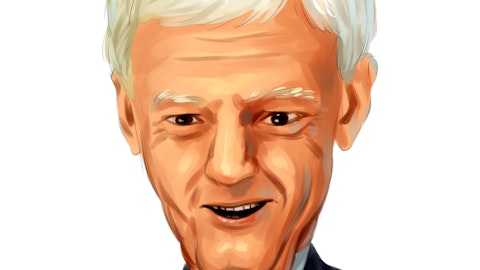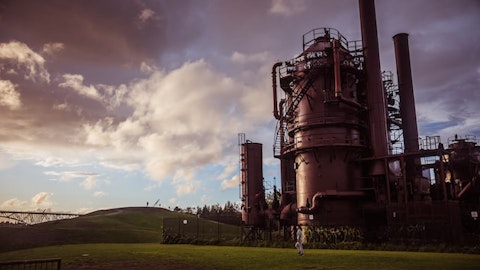And the reason is we’re already starting to realize some of these cost saves. I don’t think we’re not quite to the 15% range yet, maybe single digits, because obviously one of the biggest cost savings, which is going to take time to layer into that facility piece. That one is going to be more Q2, 3, 4. But the par on the D and the C side, where we’re already starting to see, come to fruition now, actually.
Oliver Huang: Awesome. That’s helpful. And maybe another follow-up just with respect to the facility side. Would such a change, that you all are kind of talking about, impact the expected production trajectory of well productivity? Is it more so along the lines of just kind of constraining IPs a little bit more to avoid overbuilding of the facilities? Or is it more so along the lines of just kind of using stuff that’s already existing?
Russell Parker: It’s using things that are existing, in some places, yes, you might actually see a lower IP30 but similar IP90. That’s part of the ways in which we’re saving some money. If you build everything for an IP30, your cost structure is higher. However, if you look at your rate of return, it’s better building towards an IP90. So over the year, you wouldn’t see it maybe on an exact well in an exact month, you might see a different peak. But if you were looking at a quarter of publicly available data, no, I don’t think you’d see the difference and you’d probably see more stable production over time. The other place — in some places, some of the design changes we’re talking about will actually help eliminate or reduce back pressure, which will actually improve — potentially improve some of our production on the base.
Oliver Huang: Awesome. And if I could squeeze just one more in with respect to the Q4 guide. Obviously, a downward revision there. But just wanted to see, is there any sort of breakout in terms of what could be attributed to the less oil than expected from the subset of wells that came out of the West area within the quarter versus just incremental downtime from accelerating some of the optimization that you’re doing on the artificial lift side?
Joe Gatto: Yes. The large majority will be from what we highlighted at Delaware West.
Operator: Our next question comes from Derrick Whitfield with Stifel.
Derrick Whitfield: Congrats on the structural improvements you’ve outlined this quarter.
Joe Gatto: Thanks, Derrick.
Derrick Whitfield: Starting with a follow-up on the Delaware West development. I wanted to ask if you could lean in on the learn lessons? And specifically, does the higher GOR indicate greater vertical connectivity to the lower Wolfcamp zones or simply a gassier upper Wolfcamp based on past depletion from [indiscernible] development?
Russell Parker: So I’d say that the generic learning is you’ve got to make sure you’re doing a great job, taking into account not what happen on your acreage, but offset acreage. We’re projecting that into the future, looking at how that regional depletion may impact you going forward. And then also looking at how your spacing needs to be appropriately designed or redesigned in order to optimize your capital investment going forward. There’s still plenty to do there. But yes, a lot of what it may involve is in order to maximize NAV, because you’re dealing with a little bit lower reservoir pressure as we’re talking about wells with larger completions, specifically space further apart, actually optimizes your NAV when you’re seeing that.
But that’s really, I’d say, the key learning from this is looking at bench-by-bench, what is the appropriate spacing, looking bench-by-bench to see which wells are communicating with what, where you have local geologic features, where you have localized increased depletion from offset operators to make sure that you’re optimizing your capital going forward.
Derrick Whitfield: And Russell, kind of looking forward with that development in that area, do you think you’ll have enough data kind of post this set, post assessment to have a good feel for what spacing should be as you guys look to develop that out in 2024 and 2025.
Russell Parker: Absolutely. Well, not only are we looking at fit for purpose on the DC&F side, but we’ve actually really started to unlock some of the other team members as we change our structure and really take into account and analyze quite a bit more data than we have in the past as a company. We’re actually doing a lot of exciting things around machine learning and predictions and reservoir simulation to help us improve the accuracy of our models and really have a good handle on how you can iterate on different spacing, different landing, which how many individual wells and what completion time it takes to optimize NAV per bench, which business we see are communicating with one another. We’ve been doing some exciting experiments actually to figure out fluid typing and actually being able to really see what zones are communicating with what other zones by doing what’s called like a fluid fingerprint.
So absolutely, it’s an incredible focus of our technical team, not only in this space, but everywhere, because the same learning — or the same process can be used to help you optimize your NAV all your assets.
Derrick Whitfield: I’m going to work on your side. One final, if I could, just on Page 8. Looking out into 2024, could you speak to how impactful 3-mile lateral development could be in your operational plan?
Russell Parker: Sorry, you said, how impactful 3-mile lateral.
Derrick Whitfield: Correct. Yes.
Russell Parker: Yes. Well, part of what we wanted to show there was actually not only just record lateral, but record time, which the first time saves money. In terms of how many locations we’ll have next year, that will be 3 miles, but we’re still working on our budget and figuring that out. I’d say probably the P50 answers that we’re still drilling 350, 10,000-foot wells. But we are looking for places where we could extend that wherever possible. As matter of fact in one particular location, we couldn’t even drill a straight 15,000-foot hole. So we — but we drilled basically, if you will, like an L-shape well almost or well with a bend in it in order to, one, optimize depletion of the reservoir dealing with these situations that we had, the acreage situation that we had, our footprint, but also thereby maximizing our returns.
So we’re going to be looking at that. We’re going to be looking at U-shaped wells. We’re going to look at a lot of different concepts in order to optimize our NAV but also kind of opening our lines to all within the art of the possible in terms of well shape, landing, length and time to depth.
Operator: Our next question comes from Scott Hanold with RBC Capital Markets.
Scott Hanold: And hopefully, this hasn’t been asked yet. I’ve been just jumping around to a couple of calls that are going on. But just in terms of what you all saw in the Delaware West and what you’re learning there. Can you talk about like your asset base just more at large? Is there other areas that have regional [position] or spacing that is something you’ll be cognizant of? Or is this — is this more Delaware West specific? And can you talk about where Delaware West fits into your, like, overall inventory and activity levels moving forward?
Russell Parker: So I’d say, going forward into next year, I see we’re probably going to be more heavily weighted in the East and in the Midland Basin. However, we do already have some slated projects in South and West. And honestly, you can map this, we’ve actually made some cool little movies about it, little videos. Regional pressure decline is real in all benches within the Permian. If anybody tells you that it’s not, then they’re not looking at the data. That doesn’t mean you can’t make money, however. That just means you got to take it into account when you’re building your development plans and as you continue to learn and modify your development plans. So I think, look, the process and what we learned in the Delaware West is something that you can apply everywhere.




